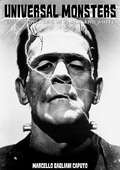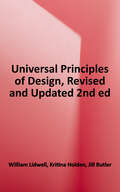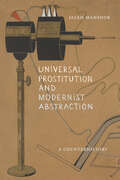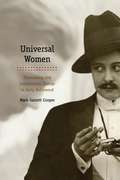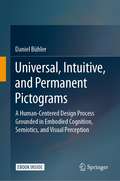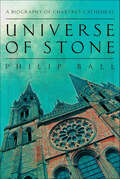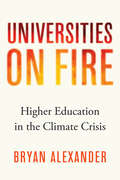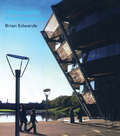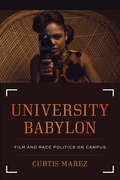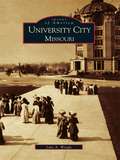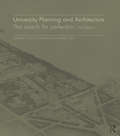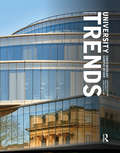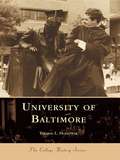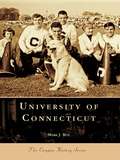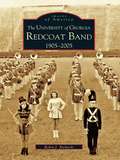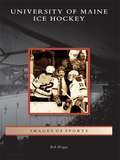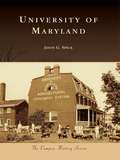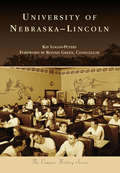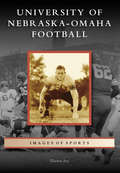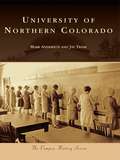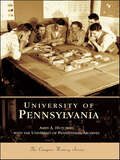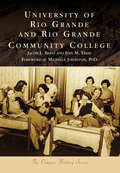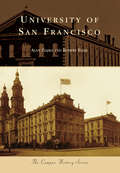- Table View
- List View
Universal Monsters: Epic Monsters in Black and White
by E. S. Dempsey Marcello Gagliani CaputoAnybody who loves scary movies will love this tribute to horror in film. From Phantom of the Opera in 1925 to the 1950s creature features, Hollywood's Universal Studios delivered fantastic films with timeless icons known worldwide: Dracula, Frankenstein, the Mummy, the Wolf Man, the Invisible Man, and the Creature from the Black Lagoon. This book looks at the performances of the stars who breathed life into the monsters -- Lon Chaney, Bela Lugosi, Boris Karloff, Lon Chaney Jr, Claude Rains, Vincent Price, and others -- while also remembering the excellent supporting players and, of course, the geniuses behind the camera who made these films both horrific and beautiful. A must for classic film lovers.
Universal Principles of Design: 125 Ways to Enhance Usability, Influence Perception, Increase Appeal, Make Better Design Decisions, and Teach Through Design
by William Lidwell Kritina Holden Jill ButlerUniversal Principles of Design, Revised and Updated is a comprehensive, cross-disciplinary encyclopedia covering 125 laws, guidelines, human biases, and general considerations important to successful design. Richly illustrated and easy to navigate, it pairs clear explanations of every design concept with visual examples of the ideas applied in practice. From the 80/20 Rule to the Weakest Link, every major design concept is defined and illustrated. <p><p> Whether a marketing campaign or a museum exhibit, a video game or a complex control system, the design we see is the culmination of many concepts and practices brought together from a variety of disciplines. Because no one can be an expert on everything, designers have always had to scramble to find the information and know-how required to make a design work—until now. <p><p> Just a few of the principles that will broaden your design knowledge, promote brainstorming, and help you check the quality of your work: <p> Baby-Face Bias <p>Expectation Effect <p>Golden Ration <p>Ockham's Razor <p>Proximity <p>Scaling Fallacy <p><p>The book is organized alphabetically so that principles can be easily and quickly referenced by name. For those interested in addressing a specific problem of design, the principles have also been indexed by questions commonly confronting designers (How can I help people learn from my design? How can I enhance the usability of a design? How can I make better design decisions? ...). <p><p> Each principle is presented in a two-page format. The left-hand page contains a succinct definition, a full description of the principle, examples of its use, and guidelines for use. Side notes appear to the right of the text, and provide elaborations and references. The right-hand page contains visual examples and related graphics to support a deeper understanding of the principle. <p><p> This landmark reference is the standard for designers, engineers, architects, and students who seek to broaden and improve their design expertise.
Universal Prostitution and Modernist Abstraction: A Counterhistory
by Jaleh MansoorIn Universal Prostitution and Modernist Abstraction, Jaleh Mansoor provides a counternarrative of modernism and abstraction and a reexamination of Marxist aesthetics. Mansoor draws on Marx’s concept of prostitution—a conceptual device through which Marx allegorized modern labor—to think about the confluences of generalized and gendered labor in modern art. Analyzing works ranging from Édouard Manet’s Olympia and Georges Seurat’s The Models to contemporary work by Hito Steyerl and Hannah Black, she shows how avant-garde artists can detect changing modes of production and capitalist and biopolitical processes of abstraction that assign identities to subjects in the interest of value’s impersonal circulation. She demonstrates that art and abstraction resist modes of production and subjugation at the level of process and form rather than through referential representation. By studying gendered and generalized labor, abstraction, automation, and the worker, Mansoor shifts focus away from ideology, superstructure, and culture toward the ways art indexes crisis and transformation in the political economic base. Ultimately, she traces the outlines of a counterpraxis to capital while demonstrating how artworks give us a way to see through the abstractions of everyday life.
Universal Women: Filmmaking and Institutional Change in Early Hollywood
by Mark Garrett CooperBetween 1912 and 1919, the Universal Film Manufacturing Company credited eleven women with directing at least 170 films, but by the mid-1920s all of these directors had left Universal and only one still worked in the film industry at all. Two generations of cinema historians have either overlooked or been stymied by the mystery of why Universal first systematically supported and promoted women directors and then abruptly reversed that policy. In this trailblazing study, Mark Garrett Cooper approaches the phenomenon as a case study in how corporate movie studios interpret and act on institutional culture in deciding what it means to work as a man or woman. In focusing on issues of institutional change, Cooper challenges interpretations that explain women's exile from the film industry as the inevitable result of a transhistorical sexism or as an effect of a broadly cultural revision of gendered work roles. Drawing on a range of historical and sociological approaches to studying corporate institutions, Cooper examines the relationship between institutional organization and aesthetic conventions during the formative years when women filmmakers such as Ruth Ann Baldwin, Cleo Madison, Ruth Stonehouse, Elise Jane Wilson, and Ida May Park directed films for Universal.
Universal, Intuitive, and Permanent Pictograms: A Human-Centered Design Process Grounded in Embodied Cognition, Semiotics, and Visual Perception
by Daniel BühlerThis book presents a complete human-centered design process (ISO 9241:210) that had two goals: to design universal, intuitive, and permanent pictograms and to develop a process for designing suitable pictograms. The book analyzes characteristics of visual representations, grounded in semiotics. It develops requirements for pictogram contents, relying on embodied cognition, and it derives content candidates in empirical studies on four continents. The book suggests that visual perception is universal, intuitive, and permanent. Consequently, it derives guidelines for content design from visual perception. Subsequently, pictogram prototypes are produced in a research through design process, using the guidelines and the content candidates. Evaluation studies suggest that the prototypes are a success. They are more suitable than established pictograms and they should be considered universal, intuitive, and permanent. In conclusion, a technical design process is proposed.
Universe of Stone: Chartres Cathedral and the Invention of the Gothic
by Philip Ball“[A] lively biography of Chartres Cathedral . . . Ball’s account of its construction reveals fascinating details.” —The New YorkerChartres Cathedral, south of Paris, is revered as one of the most beautiful and profound works of art in the Western canon. But what did it mean to those who constructed it in the twelfth and thirteenth centuries—and why was it built at such immense height and with such glorious play of light, in the soaring manner we now call Gothic?In this work, Aventis Prize winner and National Book Critics Circle Award finalist Philip Ball makes sense of the visual and emotional power of Chartres and brilliantly explores how its construction—and the creation of other Gothic cathedrals—represented a profound and dramatic shift in the way medieval thinkers perceived their relationship with their world.Beautifully illustrated, filled with astonishing insight, Universe of Stone embeds the magnificent cathedral in the culture of the twelfth century—its schools of philosophy and science, its trades and technologies, its politics and religious debates—enabling us to view this ancient architectural marvel with fresh eyes.“A terrific book . . . a lucid, thoughtful tour de force.” —The Christian Science Monitor“Engrossing . . . a resplendent account of the mysteries of Chartres Cathedral.” —Sunday Times“There is no better introduction to the subject.” —The Wall Street Journal
Universities on Fire: Higher Education in the Climate Crisis
by Bryan AlexanderScientists agree that we are on the precipice of a global climate crisis. How will it transform colleges and universities?In 2019, intense fires in the San Francisco Bay Area closed universities and drove afflicted people to shelter at other campuses. At the same time, extraordinary fires ravaged eastern Australia. Several universities responded by promising material and research support to damaged businesses while also hosting refugees and emergency response teams in student residence halls. This was an echo of the devastation wreaked by Hurricane Katrina on Tulane University in 2005.In Universities on Fire, futurist Bryan Alexander explores higher education during an age of unfolding climate crisis. Powered by real-world examples and the latest research, Alexander assesses practical responses and strategies by surveying contemporary programs and academic climate research from around the world. He establishes a model of how academic institutions may respond and offers practical pathways forward for higher education. How will the two main purposes of education—teaching and research—change as the world heats up? Alexander positions colleges and universities in the broader social world, from town-gown relationships to connections between how campuses and civilization as a whole respond to this epochal threat.Current studies of climate change trace the likely implications across a range of domains, from agriculture to policy, urban design, technology, culture, and human psychology. However, few books have predicted or studied the effects of the climate crisis on colleges and universities. By connecting climate research to a deep, futures-informed analysis of academia, Universities on Fire explores how climate change will fundamentally reshape higher education.
University Architecture
by Brian EdwardsSome of the most exciting architecture in the world can be found on university campuses. In Europe, America and the Far East, vice chancellors and their architects have, over several centuries, produced an extraordinary range of innovative buildings. This book has been written to highlight the importance of university architecture. It is intended as a guide to designers, to those who manage the estate we call the campus, and as an inspiration to students and academic staff. With nearly 40 per cent of school leavers attending university, the campus can influence the outlook of tomorrow's decision makers to the benefit of architecture and society at large.
University Babylon: Film and Race Politics on Campus (American Crossroads #57)
by Curtis MarezFrom the silent era to the present, film productions have shaped the way the public views campus life. Collaborations between universities and Hollywood entities have disseminated influential ideas of race, gender, class, and sexual difference. Even more directly, Hollywood has drawn writers, actors, and other talent from ranks of professors and students while also promoting the industry in classrooms, curricula, and film studies programs. In addition to founding film schools, university administrators have offered campuses as filming locations. In University Babylon, Curtis Marez argues that cinema has been central to the uneven incorporation and exclusion of different kinds of students, professors, and knowledge. Working together, Marez argues, film and educational institutions have produced a powerful ideology that links respectability to academic merit in order to marginalize and manage people of color. Combining concepts and methods from critical university studies, ethnic studies, native studies, and film studies, University Babylon analyzes the symbolic and institutional collaborations between Hollywood filmmakers and university administrators over the representation of students and, by extension, college life more broadly.
University City, Missouri
by John A. WrightIn 1904, from a plot of land that would soon become University City, eccentric publisher Edwin Gardner Lewis shone the beam of what he claimed was the world's largest searchlight over the World's Fair in nearby St. Louis. Several years later, he claimed an even greater possession: a city, created around his publishing complex, complete with his own mayoral office, wide boulevards, and beautiful residences. The story of University City is one of urban wonder: from the city's "Hilltop Neighbor" and namesake, Washington University, to the diversity showcased in today's University City. The historic images in this volume illustrate the area's founding and development, from the largest printing press of the time, capable of producing 300,000 eight-page newspapers an hour, to the lion sculptures at the city's famed "Gates of Opportunity," standing proud as the city's everlasting symbol.
University Planning and Architecture: The search for perfection
by Paul Roberts Jonathan Coulson Isabelle TaylorThe environment of a university – what we term a campus – is a place with special resonance. They have long been the setting for some of history’s most exciting experiments in the design of the built environment. Christopher Wren at Cambridge, Le Corbusier at Harvard, and Norman Foster at the Free University Berlin: the calibre of practitioners who have shaped the physical realm of academia is superlative. Pioneering architecture and innovative planning make for vivid assertions of academic excellence, while the physical estate of a university can shape the learning experiences and lasting outlook of its community of students, faculty and staff. However, the mounting list of pressures – economic, social, pedagogical, technological – currently facing higher education institutions is rendering it increasingly challenging to perpetuate the rich legacy of campus design. In this strained context, it is more important than ever that effective use is made of these environments and that future development is guided in a manner that will answer to posterity. This book is the definitive compendium of the prestigious sphere of campus design, envisaged as a tool to help institutional leaders and designers to engage their campus’s full potential by revealing the narratives of the world’s most successful, time-honoured and memorable university estates. It charts the worldwide evolution of university design from the Middle Ages to the present day, uncovering the key episodes and themes that have conditioned the field, and through a series of case studies profiles universally-acclaimed campuses that, through their planning, architecture and landscaping, have made original, influential and striking contributions to the field. By understanding this history, present and future generations can distil important lessons for the future. The second edition includes revised text, many new images, and new case studies of the Central University of Venezuela and Indian Institute of Management Ahmedabad.
University Spatial Development and Urban Transformation in China
by Cui LiuThe past few decades have seen universities take on a leading role in urban development, actively providing public services beyond teaching and research. The relationship between the university and the city has great influence on the space of university, which is vividly reflected in the process of university spatial development. This process has been particularly evident in China as Chinese universities and cities have been undergoing dramatic transformations since reform in the late 1970s. University Spatial Development and Urban Transformation in China explores the changing relationship between the university and the city from a spatial perspective. Based on theories and discourses on the production of space, the book analyzes case studies in university spatial development in China at three scales – global, national and local – covering social and urban contexts, the urban transformation, interactions in the development process and the changing dynamic between university and city to propose mutually beneficial planning strategies. This book is a valuable resource for academics, researchers and urban planners in identifying the key factors and relationships in university spatial development using theoretical and empirical data to guide future urban planning.
University Trends: Contemporary Campus Design
by Paul Roberts Jonathan Coulson Isabelle TaylorThe campus has a deep-rooted prestige as a place of teaching, learning and nurturing. Conjuring images of cloistered quadrangles, of sunny lawns, of wood-panelled libraries, it is a word viscerally charged with centuries of scholarly tradition. And yet it is also a place of cutting-edge science, vibrancy and energy. It is this dual nature, this concurrent adherence to tradition and innovation, which renders the physical environment of the university such a redolent, enduring and dynamic realm. However, it also means that the twenty-first-century campus is a highly challenging and exacting landscape to design and manage successfully. Today, the scale of the pressures and the rate of change facing higher education institutions are greater than ever. Squeezed public spending, growing societal expectations and the broadening education ambitions of developing nations are set against a backdrop of rapid technological progress and changing pedagogies. What are the repercussions for the physical realities of university planning and architecture? And how are university campuses adapting to contend with these pressures? University Trends: Contemporary Campus Design introduces the most significant, widespread and thought-provoking trends that are currently shaping the planning and architecture of higher education institutions across the world. Within this completely revised second edition, Part One identifies current patterns such as hub buildings, large-scale expansions, adaptive reuse and innovation buildings. Part Two profiles these through recent, well-illustrated, global case studies. The essential guide to current and future trends in campus design.
University Trends: Contemporary Campus Design
by Paul Roberts Jonathan Coulson Isabelle TaylorThe campus has a deep-rooted prestige as a place of teaching, learning and nurturing. Conjuring images of cloistered quadrangles, of sunny lawns, of wood-panelled libraries, it is a word viscerally charged with centuries of scholarly tradition. And yet it is also a place of cutting-edge science, vibrancy and energy. It is this dual nature, this concurrent adherence to tradition and innovation, which renders the physical environment of the university such a redolent, enduring and dynamic realm. However, it also means that the twenty-first-century campus is a highly challenging and exacting landscape to design and manage successfully. Today, the scale of the pressures and the rate of change facing higher education institutions are greater than ever. Squeezed public spending, growing societal expectations and the broadening education ambitions of developing nations are set against a backdrop of rapid technological progress and changing pedagogies. What are the repercussions for the physical realities of university planning and architecture? And how are university campuses adapting to contend with these pressures? University Trends: Contemporary Campus Design introduces the most significant, widespread, and thought-provoking trends that are currently shaping the planning and architecture of higher education institutions across the world. Within this completely revised third edition, Part One identifies current patterns such as student hubs, large-scale expansions and buildings for innovation and interdisciplinary research. Part Two profiles these through recent, well-illustrated, global case studies. This is the essential guide to current and future trends in campus design.
University of Baltimore
by Thomas L. HollowakSince its founding in 1925, the University of Baltimore has become one of Maryland's premier educational institutions. Originally organized as a practical solution for working men and women seeking a college degree, the institution developed rapidly-the School of Law and the College of Business Administration, begun in the founding year as evening professional schools, were joined by a day division and, in 1937, a junior college. Finally, in 1961, the university began its College of Liberal Arts to meet the demand for a relatively low-cost, liberal arts college education. Containing over two hundred black-and-white photographs from the archives of the Langsdale Library, University of Baltimore explores the school's history, from its birth in October 1925 to the present day, the eve of its seventy-fifth anniversary. From the founding of the first Greek societies and African-American clubs on campus to the anti-war protests of the 1960s, from the beginning of the sports program in 1928 to the championships won over the decades, the University of Baltimore has led a vital life and provided opportunity to a countless many. Through the images and captions contained in this visual tribute to the university, readers will meet the school's founding pioneers, as well as the administrators, faculty, and staff who have helped shape the university's past, present, and future, and most importantly, the students and alumni who have always made the University of Baltimore an exciting place to work and learn.
University of Connecticut
by Mark J. RoyIn a 50-room building that housed Connecticut's Civil War orphans, the University of Connecticut began in the fall of 1881 as the Storrs Agricultural School. From this beginning comes a rich history of change that continues through the billion-dollar program known as UConn 2000. In these pages are many previously unpublished and many long-unseen images that chronicle 120 years of that transformation. Each era in the university's history has seen growth and change: the 1890s, when faculty and administration squared off in the "the war of the rebellion"; 1908 to 1928, when President Charles L. Beach changed the curriculum and fought for "the needs of the college"; the 27-year administration of Albert N. Jorgensen, which saw a small college become a major research university; the 1960s, when, under Homer Babbidge Jr., the university made great academic advances while facing the sociopolitical challenges of the times; and today, when unprecedented changes are rebuilding and enhancing Connecticut's flagship university.
University of Georgia Redcoat Band 1905-2005, The
by Robin J. RichardsThe University of Georgia Redcoat Marching Band has grown from 20 military cadets in 1905 to more than 350 musicians and auxiliary members performing complex and entertaining halftime shows all over the Southeast today. Throughout the past century the Redcoats have been invited to participate in every major bowl game in the country and in the inaugural parade of Jimmy Carter in 1977. The University of Georgia Redcoat Band: 1905-2005 covers the first 100 years of one of the finest musical organizations in America.
University of Maine Ice Hockey
by Bob BriggsMaine's long winters would seem the ideal place for hockey to develop, but blistering winter conditions, frigid temperatures, and windchill made the sport unpleasant and even dangerous. The problem was not solved until 1976, when Harold Alfond donated a large sum of money for the establishment of a suitable facility for indoor hockey. University of Maine Ice Hockey tells the story of how a small school from Maine with a student body of under 12,000 rose to be one of the top-tier hockey programs in the nation, one of the great success stories in modern collegiate sports.
University of Maryland (Campus History)
by Jason G. SpeckOn March 6, 1856, the State of Maryland granted a charter for the creation of Maryland Agricultural College. Opening its doors to 34 eager young men in 1859, the college survived a disastrous fire in 1912 to become the University of Maryland in 1920. Today the school is a top-ranked, public research land-grant university with over 100 undergraduate majors, 120 graduate programs, and 35,000 students. Campus History Series: University of Maryland honors the history of the university and all who have contributed to its progress: faculty, staff, students, and alumni. From its earliest years, their labors and love for the institution have led to the creation of an intellectually vibrant and culturally diverse university that serves proudly as the flagship campus of the University System of Maryland. Images from the University of Maryland Archives and other campus sources, many never before published, illustrate the University of Maryland's rise from a "cow college" to an internationally recognized academic, artistic, and athletic powerhouse in the 21st century.
University of Nebraska-Lincoln (Campus History)
by Chancellor Ronnie Green Kay Logan-PetersEarly in 1869, Nebraska�s legislature convened for the first time in the new capital city of Lincoln. Eager to reap the benefits of the Morrill Act, legislators quickly approved a bill establishing the University of Nebraska. Visionary lawmakers rejected the creation of two universities and determined that the state university and the state agricultural university should �be united as one educational institution.� Thus was born Nebraska�s great land grant and comprehensive research university that serves Nebraskans and the world beyond the state. Pulitzer Prize�winning authors, Olympic athletes, and Nobel Prize�winning scientists have launched their careers at the University of Nebraska�Lincoln, as have world-class artists, entertainers, educators, and business leaders.
University of Nebraska-Omaha Football (Images of Sports)
by Darren IvyFrom its inaugural season in 1911 through its final season in 2011, the University of Nebraska-Omaha football team always faced an uphill struggle in terms of resources. The program reached a pinnacle in 1954 with its lone unbeaten season. Many other teams and individuals also found great success, winning conference titles and bowl games and moving onto professional careers. Just because the school no longer offers football, it does not mean that the thousands of men who played for the Mavericks from 1971 to 2011, the Indians from 1939 to 1971, and the Cardinals and the Maroons before should not be remembered and honored for the years they poured their hearts and souls into the Omaha football program.
University of Northern Colorado
by Mark Anderson Jay TraskThe University of Northern Colorado began in 1889 as the Colorado State Normal School, an institution dedicated to training the state's teachers. Over the next century the institution grew from a relatively small normal school into an acclaimed state university with several nationally recognized graduate and undergraduate programs. During this period of transformation, the Greeley school experienced several name changes. It was renamed the State Teachers College of Colorado in 1911, followed by the Colorado State College of Education in 1935, then simply the Colorado State College in 1957, and finally, the University of Northern Colorado (UNC) in 1970, in recognition of the institution's broadened mission. UNC's first 100 years saw dramatic changes to the physical and academic environments on campus, including advancements in the fields of education, health, music, theater arts, and human sciences.
University of Pennsylvania
by University of Pennsylvania ArchivesBy the time photography was invented in the 1830s, the University of Pennsylvania, America's first university, was nearly a century old. University of Pennsylvania, a unique photographic collection, focuses on the school's history at its present campus in West Philadelphia beginning shortly after the end of the Civil War and provides images of more than a century of student life inside and outside the classroom. In every category, from campus landmarks to the student body to the traditions that bind the community together, these photographs demonstrate the close connections between Penn's present and its past. They also reveal historical aspects of the Penn experience that have since vanished.
University of Rio Grande and Rio Grande Community College (Campus History)
by Phd Ivan M. Tribe Jacob L. Bapst Foreword By JohnstonOn September 13, 1876, the bell on Atwood Hall rang, students assembled, and Rio Grande College began its 140-year search for identity and its struggle for existence. Ira Haning, a Freewill Baptist minister, conveyed the idea of a college to a prominent couple, Nehemiah and Permelia Atwood. Nehemiah passed away in 1869, and supposedly, his last words were “Permelia, build the college.” Permelia deeded 10 acres and financed Atwood Hall and the Boarding Hall, and Rio Grande College became a reality. Upon Permelia’s death in 1885, Rio Grande faced the first of many financial pitfalls. Her estate was willed to the college, but the heirs of her second husband contested it in an action that would be resolved by the Ohio Supreme Court in 1896. As a college, junior college, community college, and currently, as a university, Rio Grande continues to seek a definitive identity.
University of San Francisco
by Robert Elias Alan ZiajkaThe University of San Francisco began in 1855 as a one-room schoolhouse named St. Ignatius Academy. Its founding is interwoven with the establishment of the Jesuit Order in California, European immigration to the western United States, and the population growth of California and San Francisco as a result of the California Gold Rush. For 159 years, the University of San Francisco has enriched the lives of thousands of people. The institution has graduated students who went on to become leaders in government, education, business, journalism, sports, the sciences, and the legal and medical professions. Among its alumni, the university counts three San Francisco mayors, a US senator, four California Supreme Court justices, a California lieutenant governor, two Pulitzer Prize winners, three Olympic medalists, several professional athletes, and the former president of Peru.
